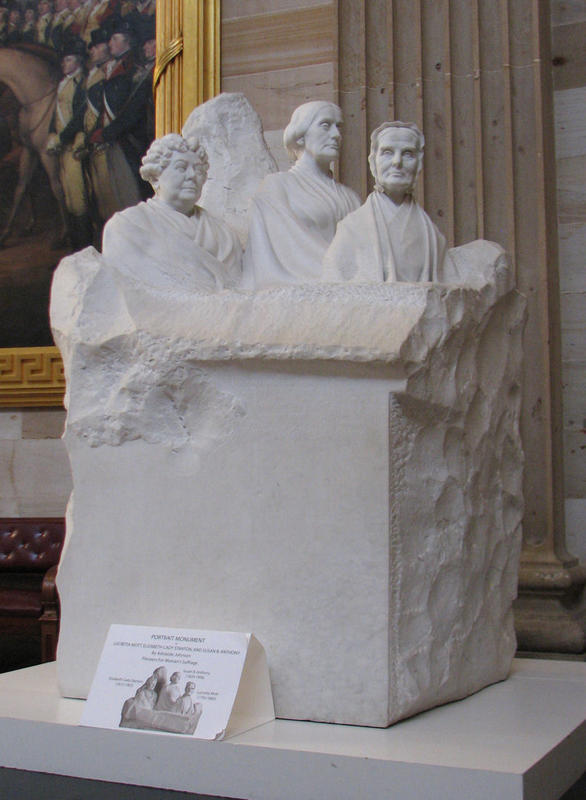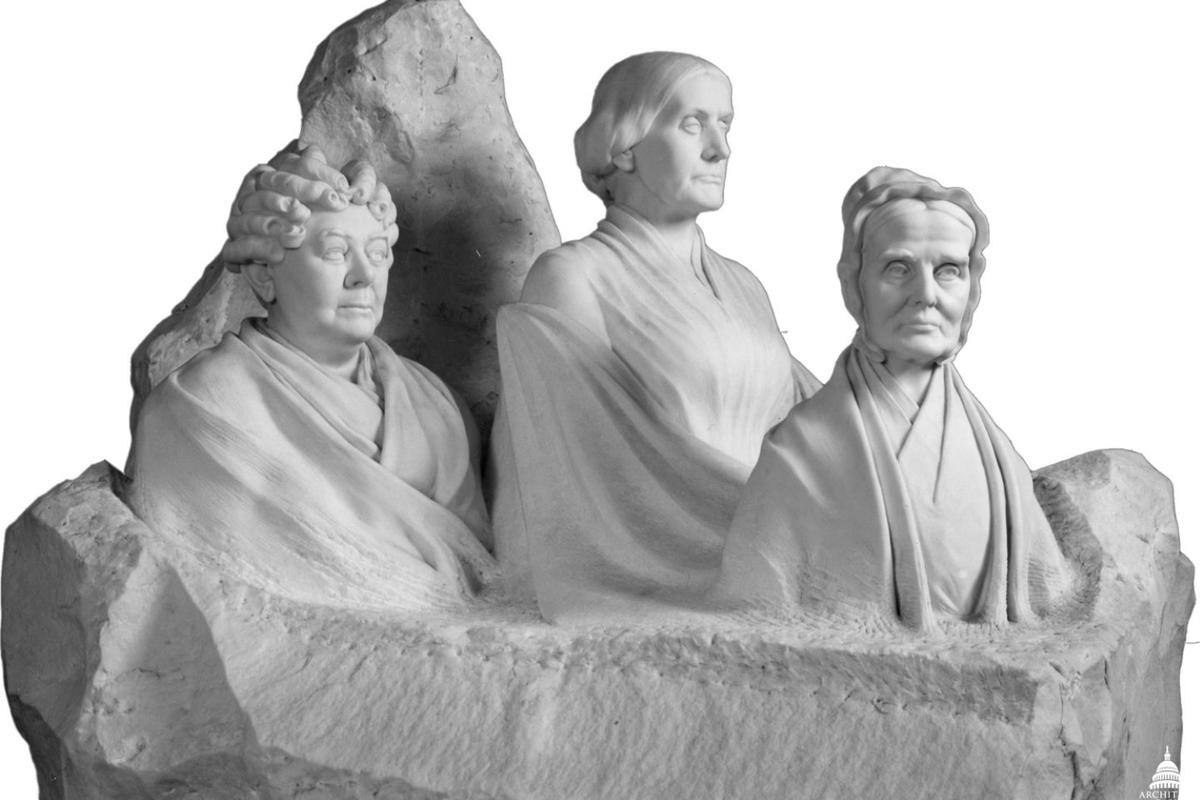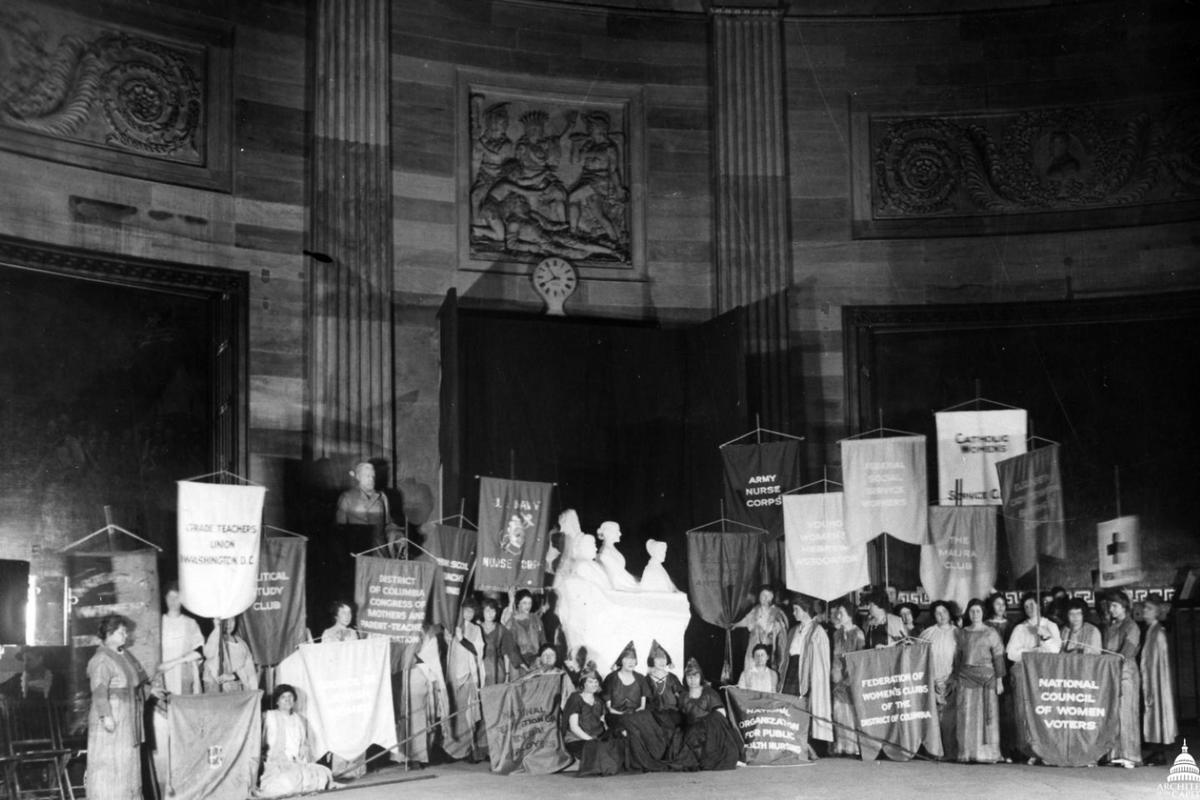More about Portrait Monument to Lucretia Mott, Elizabeth Cady Stanton and Susan B. Anthony

Contributor
Adelaide Johnson’s Portrait Monument to Lucretia Mott, Elizabeth Cady Stanton, and Susan B. Anthony is a symbol of the ongoing struggle for women’s equality that, 100 years after its creation, is still resonant today.
Fiercely independent and notoriously eccentric, Adelaide Johnson devoted her life to sculpting marble sculptures like this one, choosing to portray only prominent 19th-century women’s rights activists in her art, despite the fact that it hardly made her enough money to survive. Going against her era’s preference for bronze statues, she worked solely in white marble—seeking, perhaps, to elevate the remarkable women she sculpted in the minds of the public to the revered statues of the ancients, by using the favored medium of antiquity. An inscription on the back this statue reveals just how highly she regarded her subjects, reading, “The three great destiny characters of the world, whose spiritual import and historical significance transcends that of all others of any country or age.” Johnson firmly believed that feminism was the most important issue of her day because, to use her words, “it involved the deepest and most entrenched tyranny within creation—the tyranny of sex.” It was obvious to her that the ideas of women like Lucretia Mott, Elizabeth Cady Stanton, and Susan B. Anthony were far more pressing than those of any ancient philosopher, a stance she makes clear with her choice of white marble and inscription.
Johnson disliked most contemporary art; the only modern sculptor she ever praised was Auguste Rodin, and she was vocal about her dislike of impressionism, which she saw as a mere passing sensation (which was kind of the whole point...but moving on). Despite her preference for more traditional art, Johnson’s Portrait Monument to Lucretia Mott, Elizabeth Cady Stanton, and Susan B. Anthony was considered incredibly daring at the time of its unveiling. The statue was commissioned by the National Women’s Party in 1920 to commemorate the passing of the 19th Amendment, which finally gave women the right to vote. But when she showed the National Women’s Party what she’d come up with, they weren’t at all pleased. They wanted a traditional, full-length depiction of the three great suffragists, but what Johnson had given them was a huge, unhewn-looking block of Carrara marble with three busts just barely peeking out of the top—a metaphor, she said, for women’s continuing struggle for freedom and equality. Despite the passage of the 19th Amendment, there was still much work to be done, hence the incomplete-looking statue. The Party begged her to change it, but Johnson staunchly refused to compromise on her artistic vision. Finally, unsure of what else to do with the odd-looking sculpture, they placed it in the crypt of the US Capitol, where it would be hidden somewhat out of sight until 1997, when it was finally relocated to the more prominent Rotunda.
During her lifetime, Johnson was called “the sculptor of the women’s movement” because of her complete devotion to the cause. She dreamt of one day creating a museum to trace the history of the women’s movement, where her “white children” (as she affectionately called her sculptures) could be on full display. She was an activist as well as an artist, belonging to numerous political organizations, such as the National Woman’s Suffrage Association (NWSA), the International Lyceum Club (a professional club for women who worked in art, journalism, literature, science, and medicine), the National and International councils of Women, and the National Women’s Party. It was at an 1886 NWSA meeting that Johnson first met Susan B. Anthony, and the two women remained close friends until Anthony offered to pay Johnson $2,400 for a trio of busts she’d sculpted. Johnson was offended; she felt that this sum was far too small, and opted to keep the busts in her own private studio rather than hand them over to Anthony for such a low price. The event ruptured the women’s friendship, and when Anthony died in 1906, they still hadn’t resolved their issues.
The three women depicted in this sculpture are, from left to right, Elizabeth Cady Stanton (1815-1902), Susan B. Anthony (1820-1906), and Lucretia Mott (1793-1880). All three were key figures in the 19th century women’s rights movement. Stanton and Mott were brought together in 1840 by their shared outrage at being barred from participation in the World Anti-Slavery Convention in London on account of their both being women. Since they weren’t allowed to attend that convention, they decided they’d just host their own instead, and in 1848, they organized the Seneca Falls Convention together. It was there that Stanton read her “Declaration of Sentiments,” a document which demanded equal rights for women by inserting the word “woman” into the Declaration of Independence wherever it originally said “man," and which would contribute to the eventual launching of the women's suffrage movement. Mott was a powerful orator, frequently criticized for being “unladylike” for speaking in public, and Stanton published many influential books during her lifetime, including her three-volume History of Woman Suffrage (1881-85).
In 1851, Stanton met Susan B. Anthony, and the two of them ended up collaborating for 50 years on their fight for women’s rights. They co-founded both the American Equal Rights Association (AERA) and the NWSA together, as well as co-editing the AERA’s newspaper, The Revolution, which helped to spread their ideas about equal rights for women around the country. Like many 19th-century women’s rights activists, Anthony, Stanton, and Mott were all passionate anti-slavery advocates as well; the Seneca Falls Convention was attended by the famed abolitionist Frederick Douglass, and Stanton was friends with such notable abolitionists as Sarah and Angelina Grimke and William Lloyd Garrison.
Sadly, all three women died before they were able to see the result of all their hard work; women weren’t granted the right to vote until the passage of the 19th Amendment in 1920. But surely they would have approved of Johnson’s homage to them. Although Johnson acknowledged that much progress had been made during their lifetime, she showed symbolically in her statue that there was still much deeply-entrenched sexism to be chipped away at before women received the full equality and freedom that they’d always deserved.
Sources
- Burton, Shirley J. To Make Immortal Their Adventurous Will. Macomb, IL: Western Illinois University, 1986.
- Hayward, Nancy. “Susan B. Anthony.” National Women’s History Museum. Accessed October 23, 2020, https://www.womenshistory.org/education-resources/biographies/ susan-b-anthony.
- Michaels, Debra. “Elizabeth Cady Stanton.” National Women’s History Museum. Accessed October 23, 2020. https://www.womenshistory.org/education-resources/biographies/ elizabeth-cady-stanton.
- —. “Lucretia Mott.” National Women’s History Museum. Accessed October 23, 2020. https://www.womenshistory.org/education-resources/biographies/lucretia-….
- “Portrait Monument to Lucretia Mott, Elizabeth Cady Stanton, and Susan B. Anthony.” Architect of the Capitol. Accessed October 19, 2020. https://www.aoc.gov/explore- capitol-campus/art/portrait-monument-lucretia-mott-elizabeth-cady-stanton-and-susan
- “Sculptor Adelaide Johnson: from Illinois.” Suffrage 2020 in Illinois: The Fight for the Vote in Illinois. July 27, 2020. https://suffrage2020illinois.org/2020/07/27/sculptor-adelaide- johnson-from-illinois/.
Featured Content
Here is what Wikipedia says about Portrait Monument
Portrait Monument is a 1920 marble sculpture by Adelaide Johnson, installed in the U.S. Capitol's rotunda, in Washington, D.C. The artwork was dedicated in 1921 and features portrait busts of Elizabeth Cady Stanton, Susan B. Anthony, and Lucretia Mott.
Check out the full Wikipedia article about Portrait Monument














